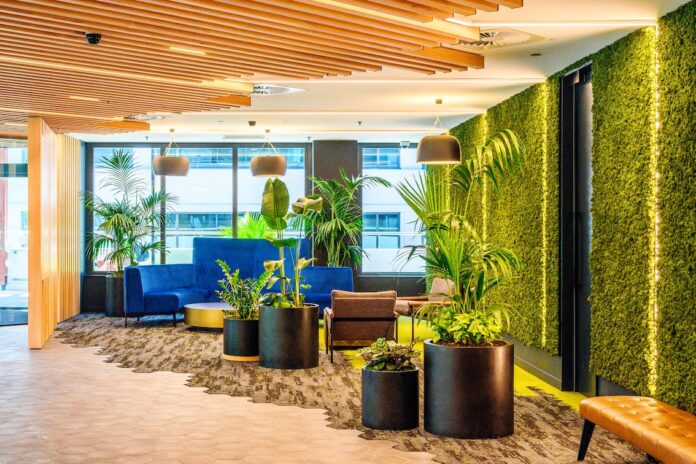A low-carbon building designed to withstand extreme climate change — that diverted more than 300 tonnes of waste from landfill during its construction — is set to be one of the largest retrofit office projects to achieve a world-leading sustainability standard.
The $54 million five-storey building at 105 Carlton Gore Road, in Auckland’s Newmarket, is one of the first developed for the post-pandemic working environment to open.
Experts say a global trend towards greener buildings is driving interest from multinational corporations and environmentally-conscious millennial workers in moving into this segment of New Zealand’s commercial real estate sector.
Argosy Property head of sustainability Saatyesh Bhana says the development has diverted more than 300 tonnes of construction waste from landfill, the equivalent volume of waste generated from 60 new house builds.
He says the property sector is a significant contributor to greenhouse gases, with buildings and their construction accounting for as much as 20% of New Zealand’s emissions.
“Internationally, businesses are motivated to lease buildings with a low carbon footprint, and which are designed to incorporate climate resilience,” Bhana says.
“When they enter the New Zealand market there is an expectation that their local presence here will align with that of their other global offices.
“To accommodate this demand, we are looking to expand our stock of properties that are sustainably constructed and energy efficient throughout their lifetime.
“In this latest project around 92% (307 tonnes) of construction waste was either recycled or repurposed — including more than 5000sq of carpet tiles which were donated to the local community.
“Life cycle assessment (LCA) modelling shows the building has a carbon footprint which is 31% lower, and an operating carbon reduction of approximately 30% less, than a reference building.
“By reusing the existing building structure, we have saved over 4,500,000kg of CO2e — roughly the equivalent of 15,500 flights from Auckland to Wellington, or taking 3000 cars off the road.”
Bhana says the building has been designed to withstand an extreme climate change scenario where New Zealand’s average annual temperatures rise by up to 3ºC over the next six decades.
He says under this scenario, elevated risks of intense summertime heating and flood risk from deluge have been mitigated.
“Local sourcing of the double-glazed extrusion system has resulted in a carbon footprint of the building’s facade that is 93% lower than a standard imported extrusion system, and a reduction in the greenhouse emissions of 560 tonnes of CO2e.
Other features include:
• a biophilic living wall made from organically grown Scandinavian moss that doesn’t require watering but can filter airborne toxins and dust out of the air,
• solar power generation,
• a building management system that responds dynamically to the presence of people at the time of day and the prevailing climatic conditions, and
• new hot water heating technology that uses CO2 and eliminates the need for traditional gas boilers.
Argosy Property head of development Marilyn Storey says the market has softened in recent months. However, enquiry for sustainable buildings is steady, particularly in the city fringe.
She says multinational tenants increasingly favour green buildings as they help attract staff to the office and lift productivity.
According to new industry data, only 1.7% (1184sq m) of Grade A office space is vacant in Newmarket, compared to a vacancy level of 16.1% of Grade B, 9.6% of Grade C, and 10.7% of Grade D commercial stock.
In comparison, the average vacancy for Auckland is 7.7% — up from 7.1% at the end of 2022.
“Against a backdrop of a flat commercial real estate sector, around 60% of the building was leased well before construction was completed,” Storey says.
“What we are seeing in the post-Covid market is an awareness from corporate employers that staff are often reluctant to return to the office. In many industries, productivity and office culture are casualties of this, and we are now developing properties to counter this reticence.
“We know that the selection of office location and quality of the building is driven by millennial staff who want visibility over the sustainability credentials of their working environment.
“In response, these offices have been designed to be reactive to the individual. So, a staff member can adjust the lighting above them through their phone if they want to.
“The facade is also able to reduce the amount of glare, and allows more natural daylight into the building.
“We have also built in a range of features which are designed to attract workers out of their home and into the office — with a green ‘oasis’ around the building that connects office and landscaping, and with 5% of our car parks dedicated to EV charging.
“In addition to having close proximity to public transport hubs, Auckland Domain and Newmarket shopping, other features which are designed to appeal to this market include large efficient floor plates, the availability of 200 car parks onsite, high-quality end-of-trip facilities with 50 bike parks, and solar.
“We have also designed 105 Carlton Gore with the latest energy efficiency technology, including intelligent air conditioning and LED lighting and control systems — providing tenants with up to 30% energy savings annually,” she says.
Storey says the first three tenants of the new building, which was designed by Designgroup Stapleton Elliott, include multinational consulting firm Stantec, Colgate Palmolive, and health care provider Harbour Cancer.
Bhana says once certified, 105 Carlton Gore Road will be the second 6 Green Star Built-rated building in the Argosy Property portfolio, behind 8 Willis Street in Wellington.




